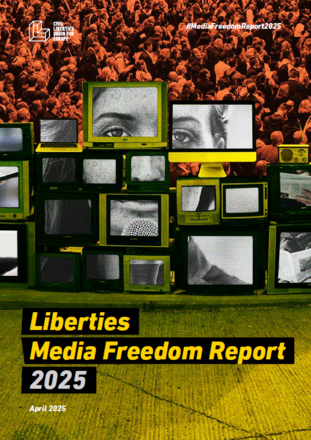
Media freedom, the first line of defence against authoritarianism, is crumbling across the EU, according to Liberties’ Media Freedom Report 2025 (Report). Governments influence the media by allocating state funding to government-friendly outlets and using public service media for their communication tools; journalists face widespread threats and violence, with female journalists targeted the most, and are denied requests for information by public officials; and weak media ownership transparency results in concentrated media ownership, the Report finds.
The Report, a collaboration of 43 human rights organisations from 21 EU countries coordinated by the Civil Liberties Union For Europe (Liberties), reveals that the overarching trends observed in last year’s report continued in 2024, a year when the media landscape was shaped not only by the European Parliamentary elections, regional conflicts, but also key new EU legislation, the European Media Freedom Act (EMFA), which was designed to address many of the critical threats to media freedom covered in this Report. As of the end of last year, many Member States seem unready – if not unwilling – to fully and faithfully enforce the EMFA, which comes fully into force in August 2025.
The diverging trends in media freedom highlight a clear correlation with broader rule of law developments, as illustrated across Central and Eastern Europe. While Hungary’s fully captured media landscape continued to erode and Slovakia trended in the same direction, Poland and Slovenia made notable efforts to restore media independence and reduce political interference. These contrasting trajectories reflect how shifts in media freedom serve as both indicators and drivers of the overall state of the rule of law.
Key findings:
- Journalist safety / Surveillance: Journalists remain vulnerable to hate speech and physical attacks, particularly at demonstrations related to the Israel-Palestinian conflict. In France, Germany, Greece, Hungary and Spain, instances of violence against journalists at protests were caused by the police. A disproportionate share of harassment and threats against women journalists in 2024 were observed in Bulgaria, Italy, Slovakia and Sweden. The use of spyware against journalists in many European countries continues to be a problem, especially for exiled journalists from Russia or Belarus.
- State interference: In 2024, governments continued to exercise influence over the media through the opaque allocation of state advertising funds or favouring government-friendly outlets (Bulgaria, Croatia, Greece, Hungary, Malta, Slovenia and Spain) and interfering with public service media and/or media regulatory bodies.
- Media pluralism: Media pluralism was strangled by a high concentration of media ownership in Croatia, France, Hungary, Malta, the Netherlands, Slovenia, Spain and Sweden. This is exacerbated by challenges to media ownership transparency; although EMFA requires publicly accessible databases, many Member States have not set them up, or they fall short of the requirements.
- Access to information: Public officials hampered journalists’ work by resisting or refusing Freedom of Information requests in Bulgaria, Germany, Greece, Malta, the Netherlands and Spain.
- SLAPPs: Abusive lawsuits, known as SLAPPs (Strategic Litigation Against Public Participation), remain a pervasive and potentially existential threat to journalists in Member States across the EU, including Belgium, Bulgaria, Croatia, France, Germany, Greece, Hungary, Italy, Lithuania, the Netherlands, Slovakia and Slovenia. In Slovakia, the Prime Minister himself was an instigator of one SLAPP case against a journalist. Only Malta has transposed the new EU Anti-SLAPP Directive ahead of its 7 May 2026 deadline.
- Public Service Media: Hungary’s PSM remains a fully captured government mouthpiece, and legislative changes in Slovakia removed all remaining safeguards ensuring independence. In less problematic countries like Croatia, Greece, Malta, Bulgaria and Italy, opaque financing and/or government control over management structures create vulnerabilities to political influence.
The content of this article can be used according to the terms of Creative Commons: Attribution-NonCommercial 4.0 International (CC BY-NC 4.0) . To do so use the the wording "this article was originally published on the Resource Centre on Media Freedom in Europe" including a direct active link to the original article page.

